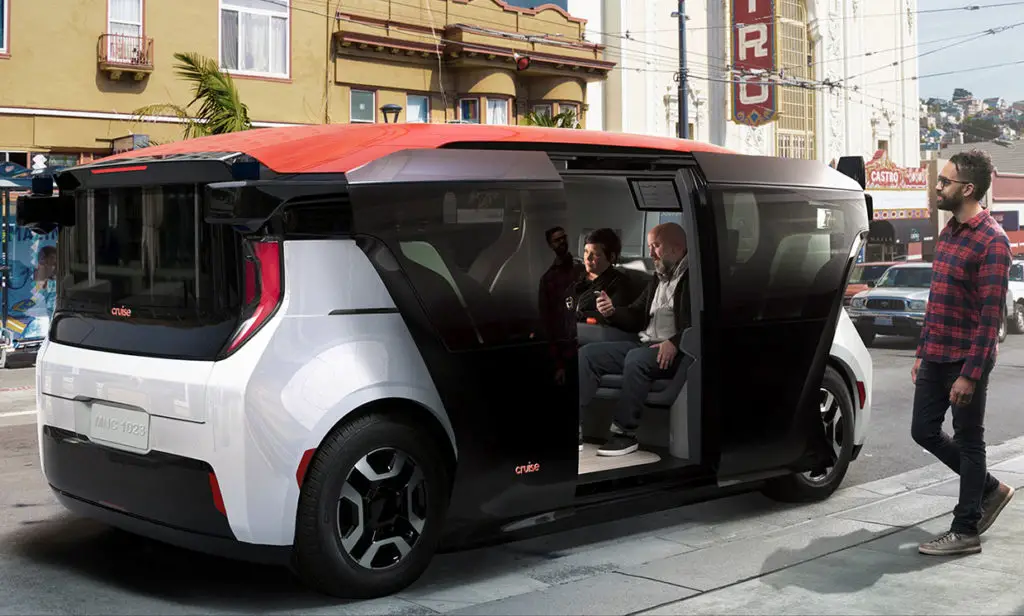Driverless ride sharing is about to go commercial with disruptor, Cruise Automation, unveiling the Origin, a fully autonomous SUV designed for app-controlled urban transportation
Uber and rival, Lyft will have to contend with a new kid on the block. And that kid might just be bigger, smarter and cheaper!

Yesterday I drove from Silicon Valley to San Francisco. It started raining on the way and I hadn’t thought to take an umbrella. No matter—I had the locations of two parking garages, just a block or so from my destination, preloaded into my navigation app. But both were full, and I found myself driving in stop-and-go traffic around crowded, wet, hilly, construction-heavy San Francisco, hunting for street parking or an open garage for nearly an hour. It was driving hell.
So when I finally arrived at a launch event hosted by Cruise, I couldn’t have been more receptive to the company’s pitch for Cruise Origin, a new vehicle that, Cruise executives say, intends to make it so I won’t need to drive or park in a city ever again.
Cruise Origin is a six-passenger, autonomous, electric, SUV-sized vehicle intended to disrupt not so much the car industry as urban transportation overall. Cruise does not plan to offer the Origin on the retail market. Instead, it will operate fleets of the vehicles as a ride-sharing service; screens inside are intended to give information about upcoming pick ups and drop offs.
Uber, which launched the last big transportation disruption and has been preparing for the next by investing in its own autonomous vehicle research, might have some scrambling to do.

Since the Origin won’t be sold, the company isn’t talking about pricing. However, Cruise CEO Dan Ammann did talk a lot about what the designers did to make this autonomous vehicle as inexpensive as possible to manufacture—production costs will be about half of those required to make today’s all-electric SUVs, he said. The designers started with a new, all-electric platform, made all the sensor and computer systems modular for easy replacement and upgrading, and took out everything driver-related, including rearview mirrors, windshield wipers, and, of course, the steering wheel.
Besides reducing costs, those omissions left room for a big passenger compartment. I do have one quibble with the design, though: in the display vehicle, passengers faced each other in two rows of seats with lots of room in between. While this arrangement might be great for Vegas party limos, those of us who are motion sensitive need to face the front and have good sight lines in the direction of travel. And, frankly, even if I weren’t motion sensitive, I don’t necessarily want to spend my travel time making awkward eye contact with a stranger.

“It costs a lot less to make than you would expect, it will last a million miles, and you can share it,” Ammann said, justifying the company’s estimate that the average urban dweller who relies on Cruise Origin for transportation will cut about US $5,000 a year from their personal transportation costs. “The key to making money is making a better user experience at a lower cost.”
The vehicle is “fully engineered and on its way to production,” Ammann said. Operating it as a driverless service still needs government approvals, however.
At the unveiling this week and in media discussions afterward, it became clearer that GM plans to have the autonomous and EV projects within the company work together. Cruise self-driving vehicles will be electric vehicles as well. But all EVs are not going to be autonomous this decade.
Who is Cruise Automation?
Cruise Automation is a Bay Area (San Francisco) company out of the Y-Combinator startup accelerator.
Cruise was originally focused on retrofitting existing cars with semi-autonomous features for highway driving but then pivoted to making EVs autonomous in urban settings.
Cruise came to the attention of GM in 2015. At that time, car manufacturers were talking up self-driving cars within 3 – 5 years.
GM bought Cruise Automation for a reported $500 million to $1 billion when it had about 50 employees. Dan Amman, president of GM (the CEO is Mary Barra), was installed as Cruise Automation president in 2018.
Cruise now has around 1,000 employees in San Francisco and a further 150 to 200 in Seattle.
In addition to the backing of GM, the company also has investment money from Softbank and Honda and a value, according to GM , approaching $15 billion so it is well placed to challenge Uber and Lyft and well as all auto-based transportation providers.
Do you expect to become carless within five years? You might finally be able to have that workshop instead of a garage!
Excepts from this article were first published in IEEE Spectrum






